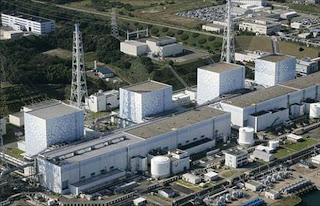 |
| Fukushima Daiichi nuclear complex in 2009. courtesy latimes.com |
The images and news from Japan continue to reach us – faster than the radiation, I hope. But despite the advanced technologies that allow us to remain hyper-informed, it is easy to feel helpless. You make a donation to a charity, you write to people who know people, you even pray. To make sense of such a nightmare—so incomprehensible in its scope—we begin to narrow in on the details. News clips that focus on a single house far offshore, a beautiful fishing boat far inland, a baby born, an elderly person found in the rubble, collectively seem better able to convey a reality that is difficult for most of us to imagine.
Ever since the Vietnam War, my generation (and those that followed) simply don’t believe what the government tells us, Republican or Democrat. Most of us on the Left don’t believe what corporations tell us, either—they have even more resources than the government to create campaigns of deception. (Remember BP = Beyond Petroleum? Now they are “shrimping again.”) In the 1970s I remember attending anti-nuclear meetings at SF State and writing letters of protesting the dangers of nuclear power. One of the anti-nuke arguments was that the government and industry were in cahoots to deceive the public. But in 1979, it was the release of the movie China Syndrome and then the Three Mile Island accident that truly dampened enthusiasm in this country for nuclear power. The lesson was the same as the war: those in power lie to the citizenry. And they do so in different ways.
 |
| Fukushima Daiichi nuclear complex in 2011 after tsunami. courtesy latimes.com |
It is this detail that I focus on this afternoon. It’s pretty clear by now that Tokyo Power, or TEPCO, has not been transparent with the Japanese government, the Japanese people, or the nuclear power regulators about what is going on in Fukushima. Of course, this isn’t the first time TEPCO has been in trouble for deception. In September 2002, five executives resigned after it was discovered that thirteen of the company’s sixteen power plants had inaccurate records regarding their reactor core structures.
 |
| The Fukushima nuclear power station in Japan. courtesy vancouversun.com |
But the deception that caught my eye today, like the odd boat in a landscape, was the graphic design on the side of the four reactors closest to the water. What do the powder blue and white fragmented square patterns suggest? A serene future? My first thought was a vending machine at an Asian airport. Then a container of disposable diapers. Or perhaps a cardboard container of milk or baby formula. Look at those disintegrating forms. Or do are they in some strange way prescient? They are just strange.
 |
| The number 1 reactor building is seen before an explosion at the Fukushima nuclear power plant. courtesy thetelegraph.co.uk |
Perhaps TEPCO wanted to diminish the scale of the structures against the water and the sky? More likely the design was, like most advertisements, an attempt to suggest that nuclear energy is clean and pure, like a baby after a bath. The most telling pictures so far have been the before and after juxtapositions of the pristine, light blue and white ‘gift boxes’ with the now-destroyed structures that hold the seemingly melting panels.
 |
| The number 1 reactor building is seen after an explosion at the Fukushima nuclear power plant. courtesy thetelegraph.co.uk |
Frankly, I prefer the concrete monolith that is the Diablo Canyon Power Plant. (Never mind that the plant was not designed with an Earthquake Emergency Plan according to Huffington Post’s Chris Kirkham: http://www.huffingtonpost.com/2011/03/16/california-nuclear-emergency-response_n_836751.html?ref=fb&src=sp). The structure is not decorated like a tissue box—it looks like the bearer of mass destruction that it may well be. For once, the much-maligned utility Pacific Gas & Electric engaged in some truth in advertising. While I admire the Japanese tendency to impose a little aesthetic improvement on the most banal objects, the decorative touch at Fukushima just seems cruel now. And while design so often reflects our ideals and not our worst fears, I prefer design to not disguise the truth of what we build.
 |
The Diablo Canyon nuclear power plant in San Luis Obispo county, California. courtesy slocounty.ca.gov |



2 comments:
Reminds me of an episode of the Simpsons in which Homer 'redesigns' the power plant in which he works by adding a stripe and some tailfins. He wins the design competition, driving his nemesis Grimes insane with frustration.
Mr. Burns: Could you explain your model, young man?
Homer: Well basically, I just copied the plant we have now.
Mr. Burns: Hmmm.
Homer: Then, I added some fins to lower wind resistance. And this racing stripe here I feel is pretty sharp.
Mr. Burns: Agreed. First prize.
Thank you. I always enjoy reading what you write, you and Malcolm Gladwell are my current favorites.
JPF in Seattle
Post a Comment